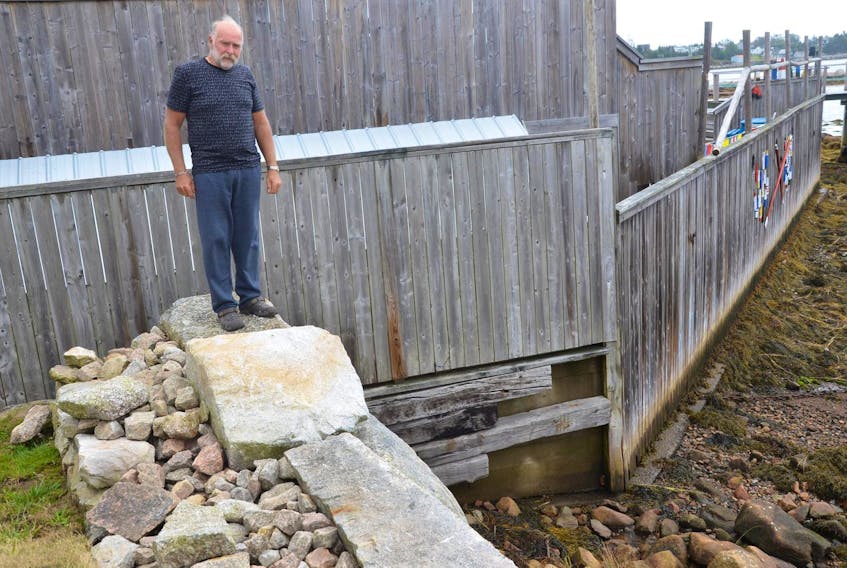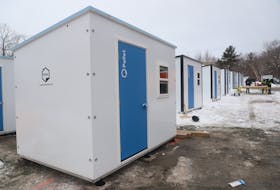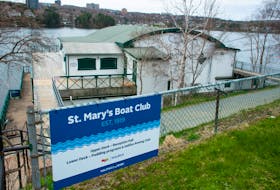KETCH HARBOUR, N.S. — Coastal water surge is expected to increase in ferocity as climate change pushes temperatures and sea levels higher.
The immediate reaction of coastal dwellers is to build barriers to hold back the water but an Ecology Action Centre coastal adaptation co-ordinator says seawalls are not always the best answer.
“Unless you are desperately trying to protect cultural artifacts or something like a cemetery and you have absolutely no other option, I think building a seawall at this point in time to try to stop what is happening is kind of like moving the chairs on the deck of the Titanic,” Nancy Anningson said. “It’s not enough. It’s not going to do it. We kind of go to seawalls as a default but there are still things behind the wall that you are not preventing.”
The walls fail and they are extremely expensive, Anningson said.
“The worst part about the walls is they actually impact the coastal ecosystems around them,” Anningson said.
“Along the shore, the whole beach is not little parcels and when you put a wall up on one section of a beach on somebody’s property, it actually accelerates the coastal erosion on the other lots, particularly the ones on either side. It chews out a vortex of tidal energy on either side of the wall. It affects the sediment transfer along the beach. We need to stop messing with these coastal ecosystems and we need to ensure that they they are adaptive and are dynamic and that they are able to respond and change.”
“Nobody else on the harbour ever, ever had to do that. Nobody had to jump through the hoops that I’m doing.”
- Alan Dempsey, Ketch Harbour homeowner
Kaitlyn Kelly of Helping Nature Heal, an ecological restoration company in Bridgewater, said the company, in its 20 years, hasn’t found seawalls to be counterproductive.
“With the effects of sea level rise, there absolutely and without a doubt needs to be some sort of engineered protection at the toe of the slope,” Kelly said in an email. “Once above the toe, a hybrid method of rock/gabion basket/concrete that has been heavily planted with shoreline and fast rooting species in the crevasses as well as a heavily planted upland with a large no-mow zone to prevent soil compaction has had the best results.”
Kelly encourages people living or wanting to live on the coast to do their research and to protect the coastlines as best as possible.
“While there is no method that will stop the force of nature completely, we can absolutely take steps to slow it down,” she said.
In Ketch Harbour, about 25 kilometres from downtown Halifax, Alan Dempsey is more concerned with fairness and consistency in getting a seawall built.
Dempsey said he and his wife June, now both retired, had applied for a permit from the provincial Natural Resources Department years ago to build a seawall beyond his property pin to stop the sea from blasting up onto his property across Ketch Harbour Road from his home. He said he was denied and told he could not construct a wall beyond his property.
Dempsey said his neighbour later applied for and was granted a permit to build a seawall eight feet beyond his and Dempsey’s properties. The neighbour’s wall propels the surging sea water onto Dempsey’s property, onto his building and deck.
“We’ve been having trouble ever since because of it,” Dempsey said.
Dempsey said he has finally been granted allowance to infill an 88-square-foot space that will permit him to move his seawall out at an angle to deflect the water from his neighbour’s wall. Dempsey said he was initially told he had to survey, buy and migrate the 88-square-foot piece before he could build the wall, at a cost he projected would be at about $5,000 to $6,000. After continued wrangling, Dempsey said the provincial department agreed to cover the surveying costs.
“Nobody else on the harbour ever, ever had to do that,” Dempsey said. “Nobody had to jump through the hoops that I’m doing.”
June Dempsey said the Lands and Forestry Department should come down and solve the problem by filling in the 88-square-foot piece instead of the Dempseys having to buy it or pay anything for it.
Area MLA Brendan Maguire said the provincial, federal and municipal governments have all been to the Dempsey property to assess the complaint. Maguire said the neighbour’s seawall was constructed before a federal legislation change and Dempsey wanted his seawall request to fall under the old legislation.
Whatever the legislation, Anningson said the hard-packed grass lawns that run up to seawalls from the property side are left vulnerable.
“There is no ability for that ground to absorb the water that’s coming down with the heavy rains that we experience. There will be extreme and more frequent weather events. The wave energy is pounding against that wall and shaking it. The energy doesn’t go away, it just shakes the wall and it shakes everything behind it. The overland water that is flowing from those rainfalls is getting trapped behind the wall instead of getting to run out. What happens over time, and we see it again and again, is that we see a collapse behind the wall.
“The wall really didn’t prevent what you are trying to stop and it impacted the shoreline on either side and caused damage to your neighbours.”









